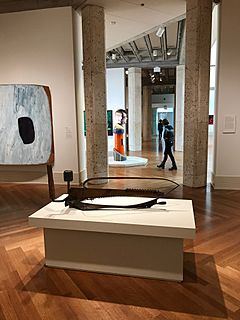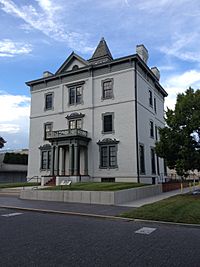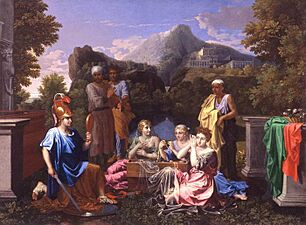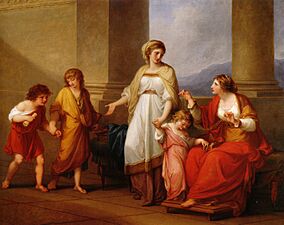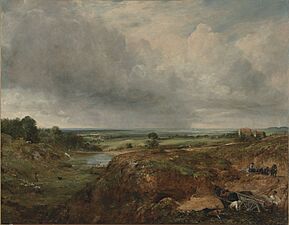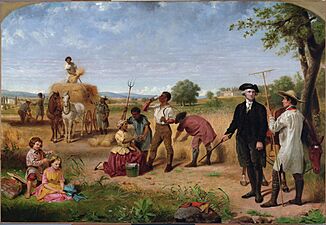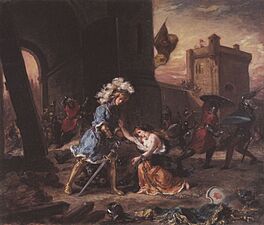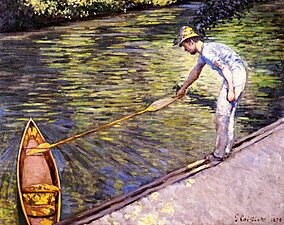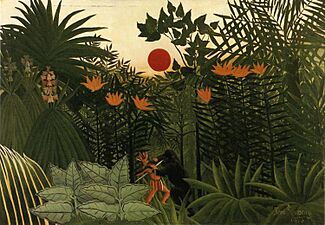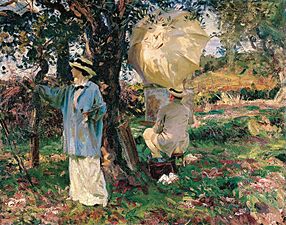Virginia Museum of Fine Arts facts for kids

The Virginia Museum of Fine Arts (VMFA) in 2010.
|
|
| Established | March 27, 1934 |
|---|---|
| Location | 200 N. Arthur Ashe Blvd., Richmond, VA 23220 |
| Type | Art museum |
| Accreditation | American Alliance of Museums |
| Key holdings | |
| Collections | Modern and Contemporary art |
| Collection size | 22,000 works (as of 2011) |
| Architect | Rick Mather & SMBW (2010 addition) |
| Public transit access | Greater Richmond Transit Company bus route 16, stop at Grove Ave. between Thompson & Robinson. |
The Virginia Museum of Fine Arts (VMFA) is a large art museum in Richmond, Virginia, that opened in 1936. It is owned and run by the Commonwealth of Virginia, which is the official name for the state of Virginia. The museum uses private donations to buy new artwork and pay for special programs.
The VMFA is one of the biggest art museums in North America. Its huge collection includes art from all over the world, such as ancient art, African art, and American art. One of its most famous exhibits is a collection of jeweled eggs made by the artist Fabergé. The museum has five of these rare Fabergé eggs, which is the largest collection you can see in public outside of Russia.
A great thing about the VMFA is that it's free to get in, although you might have to pay for special exhibits. The museum is located in an area of Richmond called the "Museum District." It also has a stage for plays and performances called the Leslie Cheek Theater.
Contents
History of the Museum
The museum started in 1919 when a judge named John Barton Payne gave 50 paintings to the state of Virginia. Later, during the Great Depression, Governor John Garland Pollard worked with Payne to get money from the government to help build the museum. It officially opened on January 16, 1936.
The museum's main building was designed to look like grand English buildings from the Renaissance period. Over the years, the museum has grown a lot, with new wings and buildings added to make more space for art.
Famous Art and New Additions
In 1947, the museum received an amazing gift: a collection of about 150 jeweled objects from Russia, including five Imperial Fabergé eggs. That same year, it also received a collection of modern art. Many other people donated money and art, which helped the museum buy even more famous pieces.
In 1951, the museum bought a painting called Chimneys by Benjamin Leroy Wigfall, a young Black art student. This was an important moment because he was one of the first Black artists whose work was added to the museum's collection.
From 1948 to 1968, the museum's director, Leslie Cheek, Jr., had many creative ideas. He started the world's first "Artmobile," a truck that took art exhibits to people in the countryside. He also kept the museum open at night, which was a new idea at the time. He made the exhibits more exciting by using special lighting and music to create a mood.
The Leslie Cheek Theater
Leslie Cheek also believed that a theater would be a great addition to the museum. In 1955, a 500-seat theater was built inside the museum. It was first called the Virginia Museum Theatre. For many years, it was home to a theater company that put on plays, musicals, and dance shows.
In 1969, a new director named Keith Fowler made the theater even more professional by hiring actors from New York City. He produced classic plays like Macbeth and also introduced new plays from around the world. One of his first shows, Marat/Sade, was famous for having both Black and white actors on stage together.
The theater company, later called TheatreVirginia, faced money problems over the years. In 2002, it had to close down. But in 2011, the theater was renovated and reopened. It was renamed the Leslie Cheek Theater to honor the director who first imagined it. Today, it hosts all kinds of performances, from plays to concerts.
Growing Bigger and Better
The museum kept growing through the 20th century. New wings were added in 1970, 1976, and 1985. These additions made space for more art, including a collection of Art Nouveau furniture and art from the Lewis and Mellon families.
In 2010, the museum opened its biggest expansion yet: the McGlothlin Wing. This new wing added 50% more gallery space. It was designed by an architect from London named Rick Mather. The design includes a huge three-story glass atrium and a new sculpture garden. This expansion won an award for its excellent architecture.
In 2019, a powerful statue called Rumors of War by artist Kehinde Wiley was placed on the museum's front lawn. The statue shows a modern young Black man on a horse. It was inspired by the historic statues on Richmond's Monument Avenue.
The Museum's Amazing Collections
The VMFA has art from almost every part of the world and every period in history. The collections are so big that they are divided into different departments.
- African Art: This collection has about 500 objects, with special focus on art from the Kuba, Akan, Yoruba, and Kongo peoples of Africa.
- American Art: This collection features art from the United States. It includes a famous painting called Portrait of a Creole Woman with Madras Tignon, which shows the French and Spanish history of the country.
- Ancient Art: Here you can see art from ancient Egypt, Greece, and Rome. The collection even has an Egyptian mummy named "Tjeby."
- Art Nouveau & Art Deco: This collection includes beautiful furniture and decorative objects from the late 19th and early 20th centuries, with works by famous designers like Louis Comfort Tiffany.
- East Asian Art: This collection has art from China, Japan, and Korea, including ancient jade, samurai armor, and beautiful paintings. It also has about 800 works by the Japanese artist Kawase Hasui.
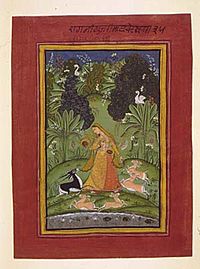
- European Art: This collection features paintings by famous European masters like Goya, Poussin, and Gentileschi. It also has a large collection of French Impressionist art and British sporting art donated by Paul Mellon.
- Fabergé: The museum is world-famous for its collection of jeweled treasures made by the Russian artist Fabergé. It includes five Imperial Easter Eggs made for the Russian royal family.
- South Asian Art: This collection includes art from India, Nepal, and Tibet. A highlight is a 27-ton marble garden pavilion from an Indian palace.
- Modern and Contemporary Art: This collection features art from the 20th and 21st centuries. It includes many works collected by Sydney and Frances Lewis, who were friends with many of the artists.
Gallery of Famous Paintings
-
Rubens Arachne.jpg
Peter Paul Rubens, Study for Pallas and Arachne, 1636–37
-
Artemisia Gentileschi - Sleeping Venus.JPG
Artemisia Gentileschi, Venus and Cupid
-
Nicolas Poussin, Achilles on Skyros, 1656
-
Élisabeth Vigée-Lebrun, Portrait of the Comte de Vaudreuil, 1784
-
Angelica Kauffman, Cornelia, Mother of the Gracchi, 1785
-
John Constable, Branch Hill Pond, Hampstead Heath, 1825
-
Eugène Delacroix, Amadis Delivers Princess Olga from Galpans Castle, 1860
-
Gustave Caillebotte, Boater Docking His Skiff, 1878
-
Henri Rousseau, Tropical Landscape: American Indian Struggling with a Gorilla, 1910
-
John Singer Sargent, The Sketchers, 1914.
Special Exhibitions and Programs
The VMFA often hosts special exhibitions that are only on display for a limited time. These shows might feature art from other famous museums or focus on a single artist.
Some of the most popular past exhibitions include:
- Splendors of Ancient Egypt (1999): This show featured amazing artifacts from a museum in Germany and was seen by almost 250,000 people.
- Picasso: Masterpieces from the Musée National Picasso (2011): The VMFA was one of only seven museums in the world to show this collection of paintings by the famous artist Pablo Picasso.
The museum also has many educational programs. It offers art classes for all ages in subjects like drawing, painting, and photography. Since 1940, the VMFA has given money to Virginia artists to help them with their careers. This program has helped many artists become successful.
Images for kids
See also
 In Spanish: Museo de Bellas Artes de Virginia para niños
In Spanish: Museo de Bellas Artes de Virginia para niños


